I would consider myself a semi pro polisher, at best. Winter is waning and spring is on the horizon… maybe. I’m settin by the window waiting for the delivery guy to get here with my test kit from SIC RIGZ Polish by Caliva’s Polishing Products. They come highly recommended by my supplier and I’m excited to try their line of products. I’m always looking for new and better ways to get the old work horse tuned up and standing tall. It’s too miserable around here to go trucking. The winds blowing pretty good today and the snow is still on the ground, so I’m going back to school and tuning up my polishing skills.
Detailing is more than polishing the wheels and front bumper. So, what is detailing and who can teach you how to do it? Most of us think only of our big trucks and polishers like the guys out in Barstow, Casa Grande, or maybe Wildwood, Florida. Not so fast there, homeboy. The act of detailing is to treat the whole package, and that includes all types and kinds of vehicles. A good shop should be able to handle everything from your semi to your pickup, and even the wife’s new Mercedes. When we talk about all vehicles, we also mean all of the vehicle. Inside, outside, and under the hood, including the tires.
But there’s more to detailing than just knowing what products to purchase, you also need to know how and when to use them. It may be hard to teach an old dog new tricks, but it’s not impossible. So, I’m working on my “Just Steppin” Peterbilt as my test vehicle. Bear in mind this old rig has 2+ million miles on it, and none of them were easy ones. When in doubt, reach out to the professionals. This old man is getting schooled.
So, how can you tell the difference between a pro and a semi pro? First off, the pro, or professional, is someone who has a specific skill and makes a living doing it (unlike truck drivers who work for days just to pay for dinner). This is a person who has learned their trade or profession at a considerable financial and time investment. A semi pro is a truck owner or driver who dabbles at the same skill with varied degrees of success.
If you’re still unsure, the semi pro is often too cheap to pay for said service or is not in a location close to the place offering the work. Therefore, they learn some of the basic moves, then dabble at doing their own detailing. This situation can apply to much of the side jobs we as drivers do. In the past I have written about lumpers, people who are paid to load and/or unload trailers at grocery warehouses, and even some tire services that do road repair, but this time I’m gonna get down and dirty and get the skinny on putting your shine on.
It’s the end of snow season and soon to be show season, and we all know what that means. The four stages of truckin’ are soon to begin: drive the truck, wash last week’s grime off, shine everything you can find, and then drive to a local event to show your pride on the weekend. Then repeat. Be sure to keep picking up and reading your 10-4 Magazine, because it is the premier publication for truck show coverage and the best place to find high quality iron – am I right? I’m already thinking about MATS in Louisville, KY. Whether you are planning to go there to compete or not, there will be plenty of other shows, and we want you – our faithful readers – to be ready.
I’ve been fortunate over the years to have experimented with different ways to get my trucks to look acceptable, and even won some shows, along the way. The only constant in life is change, but it’s hard to keep up with those changes when you are so busy doing your job.
I want to take a survey and see who has been duped by some slick snake oil salesman selling a “brand new just on the market, one of a kind, world’s best polish” in the truck stop parking lot? “Now look here, ladies and gents, this product can’t be purchased in any store or online, and it’s only available today and today only. I’m gonna make you a deal.” He just wants to get something to eat and call it a day (or so he says). “Here, let me show you on your truck.” And before you can answer he has already placed the “magic sauce” on your truck and is making small circles in the middle of your fuel tank.
The place where the “salesman” rubbed looks far better than the rest of your truck, so now you have to finish the job. Don’t worry, he has one bottle left, and it’s only 25 dollars, a steal at that price, or so he says. What do you do? Pay the man and get to work, right?! Only problem is, as soon as you start working, you quickly realize that it doesn’t look as good as the spot done by the salesman. Yea, he’s gone, and so is your money. Spoiler alert people – it’s not the same stuff. Most of the time it’s nothing more than lighter fluid or mineral spirits, along with some white rouge shaved into a bottle. The product he tested looked the same, but was far more expensive, and had actual cleaning compounds and polishing agents in the mix. Lesson learned.
There is more to prepping a vehicle than just shining up the metal parts. There’s also the paint, glass, vinyl, and rubber. If you’re entering a competition, all these areas will be judged for points. If you have a new truck, it doesn’t take much to get it looking great, but if you are using your work horse in rough or extreme conditions regularly, then it’s harder to get it ready for a show. This is especially true coming out of winter when we tend to neglect the rig and just eat miles (show me the money).
The most coveted award of any truck show is the Best in Show trophy. In order to compete at that level, you will need to display your engine and expose the wiring, the front axle area, the frame, and everything else. If you run down south on Interstate 10 all winter, your truck might stay clean longer and hold its shine. Now, for the rest of us, not so much. The further north you roam the more severe the conditions. For our Canadian readers, who come down every year, my hat goes off to you. I’m thinking about Jade Transport (the Dyck family) from Manitoba, Canada, and Mr. “King of the Road” aka Pierre Cinq-Mars of Quebec. They don’t just wander south of the border randomly to compete in truck shows, they bring their A-Game all the time, and every time.
In order to bring the A-Game you need to stay on top of your finish all year. The best way to do that is to find a shop that specializes in high-end detailing. Get to know the people doing the work and, when possible, hire them. Even if it means making an appointment and/or laying over for the weekend. Most of them will accommodate your schedule or even travel to you to do work. The cost of a motel is still a write-off, as for as the tax man is concerned. The better you condition your equipment, the easier it will be to maintain it.
I have been fortunate to know more than one detailer, and recently reached out to one whom I have been impressed with. I really like her work and her “let’s do this” attitude. You read that right, “her” work. Trucking is no longer a man’s world and that means women are doing many of the subset jobs. Who better to accent your ride than a lady who uses eye shadow every day? Ouch, I’m gonna get hate mail for that remark! No, really, I’m talking about bringing the complete package.
Most of our 10-4 readers know I hail from the north coast of America near the Canadian border. We truck up here in the Great Lakes region and call the state of Michigan home. That means long and wet (or white) winters. Mixed in that white is salt and road deicer, some coal dust, and maybe even a handful of lava rock, just for good measure. So, how do you save your paint from the corrosive effects all this causes? First, let’s go to someone who lives in the north, upstate New York, to be exact, not too far from Buffalo and the snow belts east of Lake Erie. It doesn’t snow there once in a while – it snows almost all year! Well, not really, but they do get 85 inches of snow a year and an additional 39 inches of rain. That’s way too much moisture to keep your shine on without getting some professional help. Don’t ever believe someone like myself knows everything about all things because I don’t. I do, however, have a secret weapon when it’s time for my A-Game to step up.
One of my secret weapons is Perry Soper of PMS Detailing and Polishing. I have been working on a project for aluminum prep and reached out to Perry for ideas to help ladies handle buffers and grinders easier when working on their trucks. Her first comment was, “Just finding downsized tools can be a challenge unless you know where to look.” Before I asked for her opinion, I didn’t know that was even a thing. I assumed all tools were designed alike. Now I know there is a difference and will be passing that information on to others when asked.
Most of my requests for help are for basic “how to” tips for beginners. We have had a number of requests from the ladies, so I have been experimenting with new techniques, trying different ways to reduce strain on my arms and hands. Contrary to popular opinion, not all drivers are 6’-3” and 240 lbs. Some are 5’-2” and, soaking wet, might tip the scales at 110 lbs. I’m a firm believer that it’s not the size of the driver that counts, it’s the drive in them that matters.
We all know jobs come in multiple sizes, and cleaning supplies do, as well. Most of us are familiar with the poplar national brands of polish or aluminum dressing, and frequently see them in the fuel stops and chrome supply stores. Are they the only choice? Do they also make rubber or vinyl cleaning products? If not, how do you find out about the others? Spoiler alert: I said earlier these detailers are professionals and make their living doing this. They don’t just polish, most of them sell cleaning products, too.
If you want good advice, it comes at a cost. You wouldn’t go to the dentist to have a tooth looked at and not expect a bill for the office call. I talked about this over a long text conversation and had my thoughts confirmed. Different products will perform differently, given location, temperature, and humidity. What works in Southern California might not work as well in New York or Maine – even on the same truck. Maintenance, after you get cleaned and prepped, is another thing. Usually, there aren’t any instructions on the bottle, and that’s where your detail shop fills in the blanks (they really are worth the money if you can find a good facility). We had a long conversation about best practices and “how to” tips for the products she was sending.
As I talked with Perry, I asked her, “What was the best advice you received when starting out?” Now hold on to your hat, because this is good, and it can be applied to any project. Her answer was, “Get informed and embrace and trust the process. Trust yourself and your tools, and remember, just because you use a big name-brand product doesn’t always mean that it’s good.” I really like her honesty and bold straight talk. She went on to explain there will never be a one bottle cure. All polish materials and “how to” videos can be misleading. That doesn’t mean you shouldn’t try to learn from them but take all advertisements as questionable information. Then, go out and do your own research.
Any technique should be explored, and if it works for you, great. If not, don’t count it as a failure. This new information is an unused tool in your toolbox for possible use at a later date. As we ended our conversation, Perry shared this gem of knowledge, which I will enter into my “pearls of wisdom” book someday. She said, “At the end of the day, any shop can make stuff shine, but the shops that make the shine last are the ones who follow the process, from beginning to end, and then take the time to explain proper maintenance to their clients. I think that’s what sets me apart more than anything.”
How and where do you get this “good advice” and what should it cost? Since I live in an area that has few real detailers, I order most of my products online and have them delivered to the shop. Now, is it best to order from the manufacturer directly or from a retailer? That’s a question for the end user (you) to consider. I have been in the habit of ordering from the retailer and seeking out their helpful hints on the best use of the products. Most retailers often carry more than one brand, depending on the depth of each line, so they know all the products well. I prefer to keep multiple brands and types of cleaners on-hand just in case the first choice doesn’t work.
Most retailers have a markup above the manufacturers’ cost, which is why it can be cheaper when ordered direct, but that’s how retailers get paid for their knowledge. I have not had good luck talking with salespeople for wholesalers online, or getting any useful information from them, either. I would suggest using a specialty detailing shop for this one. Stop by their shop, get to know them, get tuned up from time to time, but don’t make yourself a nuisance. We all like to see and be seen at the poplar hangouts, but they are places of business, and these folks need to get their work done, too.
I hope none of you were looking for step-by-step instructions on a spring cleanup. That would take far too long, and I may not be your best source for that. I can, however, get you headed in the right direction, if you are willing to put in some research time and plan ahead. There are many good detail shops around the country – take the time to stop by one and make some new friends. Be prepared to shake hands with a firm grip. Most of them have dirt under their nails and sweat on their brow. That just kind of happens when your best friend is a bar of rouge and a grinder.
Perry told me, “Detailing ain’t for sissies, and I will let my work speak for itself.” I can’t add any more than that! Take pride in your ride and (hopefully) ride it to the head of the class. I hope to see many of you at MATS in Louisville and can’t wait to see all the pressed-out rigs. Let’s see who gets the attention of our editor while there and lands on the pages of a future issue of 10-4 Magazine. Now, show me again how to POP that polish cloth, 10-4!


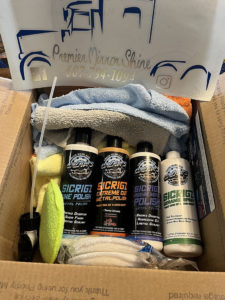
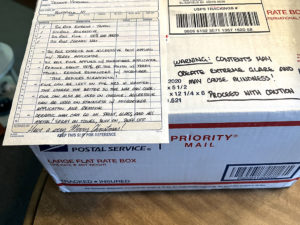
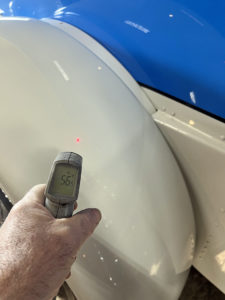
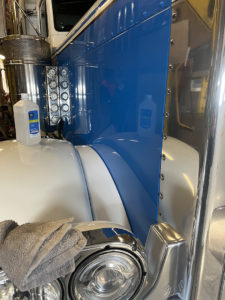
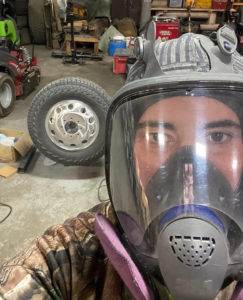
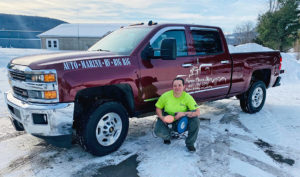
1 Comment
Perry has world class skill as a polisher and detailer. We are very proud to have her with us on the SicRigz team!